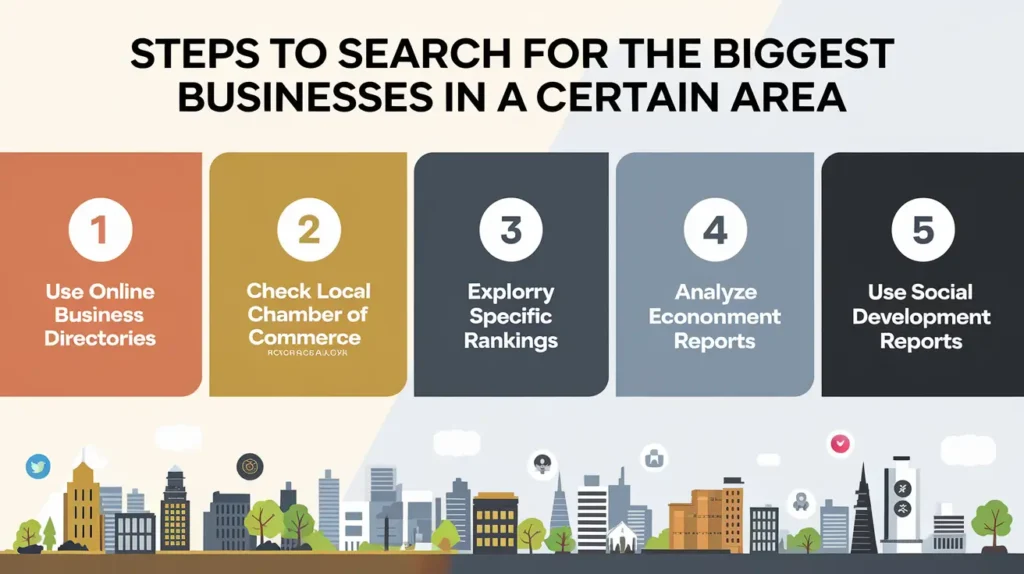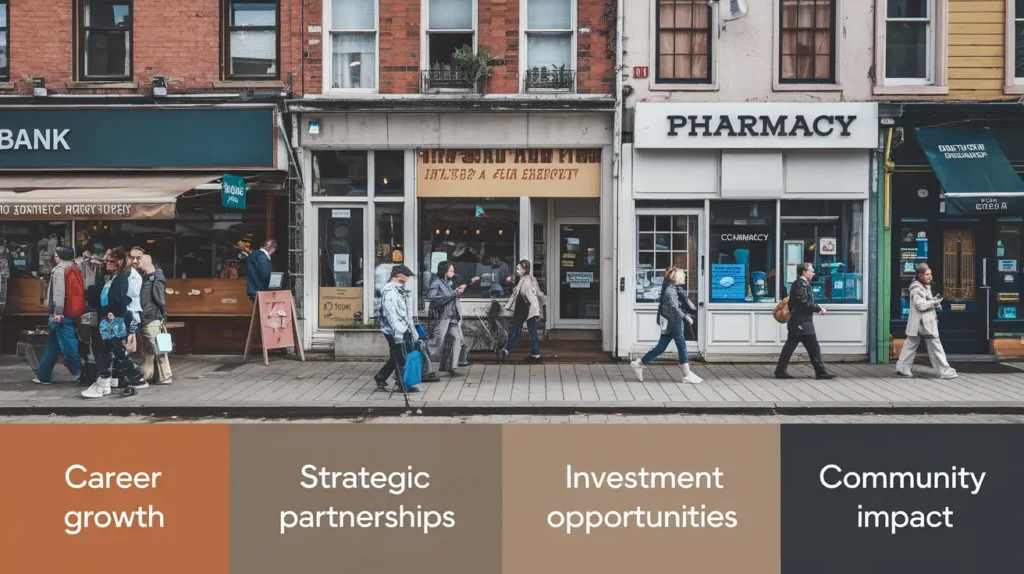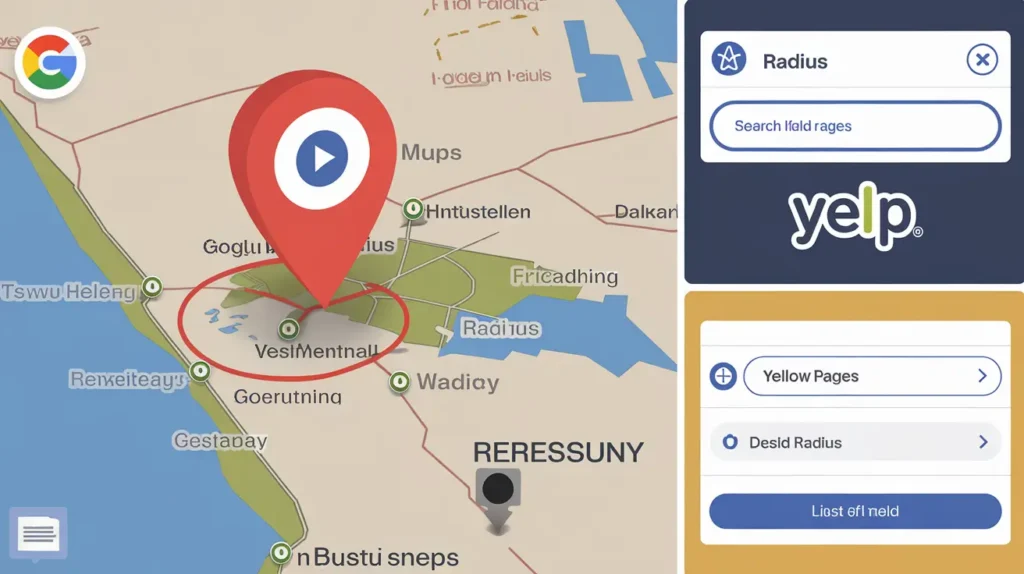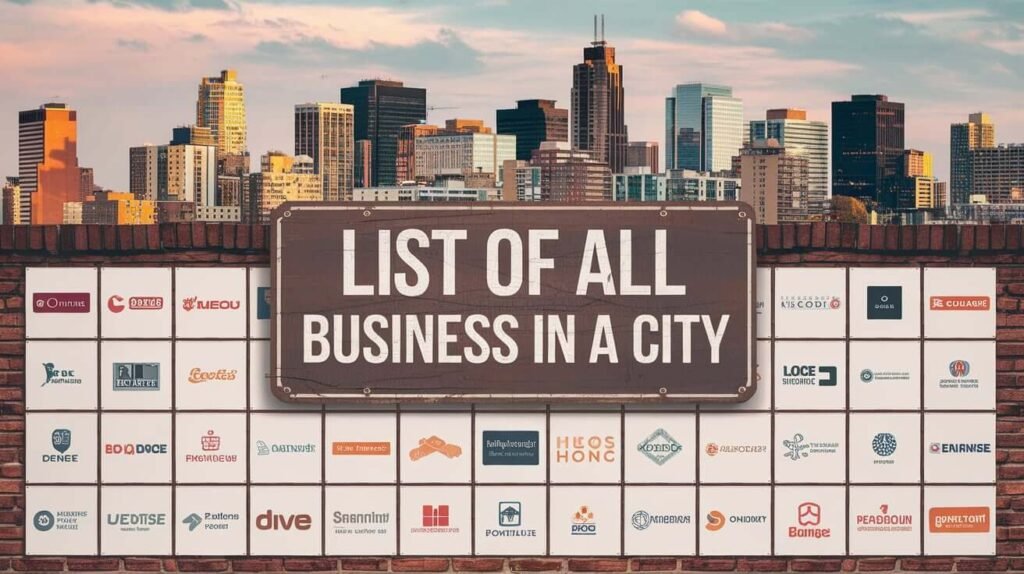How to Search for the Biggest Businesses in a Certain Area: 10 Powerful Steps to Search
In today’s interconnected world, understanding local economies is crucial for various stakeholders, including job seekers, investors, and entrepreneurs. How to Search for the Biggest Businesses in a Certain Area: 10 Powerful Steps to Search is a valuable guide that equips you with effective strategies to identify top businesses in any location, helping you make informed decisions and gain a competitive edge.

This article will guide you through effective methods, tools, and strategies to identify leading companies in a particular region.
Table of Contents
- Why Identifying the Biggest Businesses in a Certain Area Matters
- Steps to Search for the Biggest Businesses in a Certain Area
- 1. Use Online Business Directories
- 2. Check Local Chamber of Commerce Listings
- 3. Explore Industry-Specific Rankings
- 4. Analyze Economic Development Reports
- 5. Use Social Media Platforms
- 6. Conduct a Google Search with Targeted Keywords
- 7. Explore Public Records and SEC Filings
- 8. Leverage Local Networking Events and Job Fairs
- 9. Use Mapping and Analytics Tools
- 10. Collaborate with Local Universities and Research Institutions
- Also Read: How to Start a Box Truck Business: 2 Smart Ways to Choose Your Perfect Box Truck Type
- Tips for Refining Your Search
- The Benefits of Finding the Biggest Businesses in a Certain Area
- Challenges in Identifying the Biggest Businesses in a Certain Area
- Tools and Resources for Finding the Biggest Businesses
- Case Studies: Finding Top Businesses in Key Regions
- Future Trends in Identifying Top Businesses
- How to Find Companies in a Specific Area?
- How to Find Businesses Within a Radius?
- How to Find the Number of Businesses in an Area?
- How Do People Find Local Businesses?
- Locate Companies by Industry and Other Criteria
- Google Maps
- How to Find Businesses by Industry:
- How to Search for the Biggest Businesses in a Certain Area Online?
- List of All Businesses in a City
- Chamber of Commerce
- How to Find on Google Map Chamber of Commerce
- Conclusion:
- FAQs: How to Search for the Biggest Businesses in a Certain Area
- 1. Why is it important to identify the biggest businesses in a certain area?
- 2. What tools can I use to find the biggest businesses in a specific region?
- 3. How can I ensure the information I find is accurate?
- 4. Are there free resources to find the biggest businesses in a certain area?
- 5. Can I find the biggest businesses in an industry-specific way?
- 6. What information should I look for when researching a company?
- 7. How do I find private companies that don’t disclose financial data?
- 8. Can social media platforms help in identifying top businesses?
- 9. What is the role of local networking events in identifying top businesses?
- 10. How frequently should I update my research?
- 11. Are there specialized apps for identifying local businesses?
- 12. How do I find the biggest businesses in rural or less-developed areas?
- 13. Is it possible to find emerging businesses in an area?
- 14. Can public records help in identifying the biggest businesses?
- 15. How can I use job boards to identify top employers in a region?
Why Identifying the Biggest Businesses in a Certain Area Matters
Understanding the largest businesses in an area offers insights into the local economy, job opportunities, and market trends. These businesses often set the tone for regional economic health, influence supply chains, and attract talent. Whether you’re a job seeker targeting top employers or an entrepreneur seeking partnerships, identifying these companies is an invaluable step.

Steps to Search for the Biggest Businesses in a Certain Area
1. Use Online Business Directories
One of the easiest ways to search for the biggest businesses in a certain area is by leveraging online business directories. Websites like LinkedIn, Yelp, and Google My Business offer extensive databases of companies categorized by location and industry.
- LinkedIn: Utilize the advanced search feature to filter companies by size, location, and industry.
- Yelp: While typically used for local services, Yelp also lists businesses with customer reviews, giving insights into their reputation.
- Google My Business: Search directly on Google Maps to identify highly rated or prominent businesses in a specific area.
2. Check Local Chamber of Commerce Listings
Local chambers of commerce maintain comprehensive databases of businesses operating within their jurisdiction. These listings often highlight the biggest businesses in a certain area based on revenue, employee size, or regional impact.
- Visit the chamber’s website or contact them for reports.
- Look for annual publications, like “Top Employers” or “Business Spotlights.”
Chamber of commerce data is a reliable source for identifying established companies.
3. Explore Industry-Specific Rankings
Some industries maintain their own rankings or directories, which can help you find the biggest businesses in a certain area within a specific sector. For instance:
- Construction: Search industry magazines or associations like the Associated General Contractors of America.
- Technology: Use platforms like Crunchbase to explore startups and major players in tech.
- Healthcare: Research hospital networks or pharmaceutical companies.
Targeted searches allow you to pinpoint the most influential businesses in your desired sector.

4. Analyze Economic Development Reports
Local governments or economic development agencies often publish reports on the biggest businesses in a certain area. These reports provide an authoritative source of information and may include:
- Revenue data
- Employee counts
- Industry contributions to the local economy
Visit city or state websites, or check with economic development organizations for detailed business insights.
5. Use Social Media Platforms
Social media platforms like Twitter, Facebook, and Instagram can be unconventional yet effective tools to search for the biggest businesses in a certain area. Many companies actively promote themselves on these platforms, highlighting:
- Awards or achievements
- Community involvement
- Key partnerships
Search hashtags, location tags, and trending topics to uncover leading local businesses.
6. Conduct a Google Search with Targeted Keywords
A simple yet powerful method to search for the biggest businesses in a certain area is using Google with targeted phrases. For example:
- “Largest companies in [city/state]”
- “Top employers in [location]”
- “Major corporations headquartered in [area]”
This technique often leads you to curated lists or articles highlighting major businesses in your area of interest.
7. Explore Public Records and SEC Filings
For publicly traded companies, accessing financial statements or SEC filings can provide detailed insights into their size and revenue. Tools like EDGAR (Electronic Data Gathering, Analysis, and Retrieval system) allow you to search for businesses by location or industry.
- Focus on key metrics such as market capitalization, revenue, or number of employees.
- Compare public data with other resources to validate findings.
8. Leverage Local Networking Events and Job Fairs
Networking events, trade shows, and job fairs are excellent opportunities to learn about the biggest businesses in a certain area. Many large companies participate in such events to attract talent, partners, or investors.
- Attend events hosted by chambers of commerce or professional organizations.
- Engage with company representatives to gain firsthand insights.
Face-to-face interactions often yield valuable information not found online.
9. Use Mapping and Analytics Tools
Geospatial and business analytics tools like GIS (Geographic Information Systems) or specialized platforms like Hoover’s and ZoomInfo can help locate and analyze the biggest businesses in a certain area.
- GIS tools visualize the geographic distribution of businesses.
- Hoover’s and ZoomInfo provide detailed profiles, including financials, for major companies.
These tools are particularly useful for data-driven decision-making.
10. Collaborate with Local Universities and Research Institutions
Many universities and research organizations maintain databases of local businesses for academic or economic research purposes. Partnering with these institutions can grant access to exclusive datasets or publications.
- Visit university websites or contact business research centers.
- Look for local economic studies featuring large companies.
These collaborations often uncover hidden gems not listed in traditional directories.
Also Read: How to Start a Box Truck Business: 2 Smart Ways to Choose Your Perfect Box Truck Type
Tips for Refining Your Search
Focus on Specific Criteria
When searching for the biggest businesses in a certain area, define your criteria clearly. Are you interested in revenue, employee size, or industry influence? Narrowing your scope ensures more accurate results.
Stay Updated
Business landscapes evolve rapidly. Regularly updating your research helps you stay informed about emerging leaders in your target area.
Validate Your Findings
Cross-reference data from multiple sources to ensure accuracy. This is particularly important when making decisions based on your findings.

The Benefits of Finding the Biggest Businesses in a Certain Area
1. Career Growth
For job seekers, targeting large businesses often translates to better opportunities, higher salaries, and robust benefits.
2. Strategic Partnerships
Entrepreneurs and small business owners can leverage partnerships with large companies for growth and exposure.

3. Investment Opportunities
Investors gain insights into thriving industries and potential prospects by identifying key players in a region.
4. Community Impact
Understanding the biggest businesses in a certain area helps you gauge their contributions to local development, such as job creation and philanthropy.
Challenges in Identifying the Biggest Businesses in a Certain Area
While identifying the largest businesses can be highly beneficial, the process is not without challenges. Here are some common obstacles you might face and how to overcome them:
1. Outdated Information
Business landscapes change quickly due to acquisitions, closures, or expansions. Relying on old data can lead to inaccurate conclusions.
Solution: Always use updated resources such as recent reports, news articles, and online directories that refresh their listings frequently.
2. Limited Access to Data
Private companies are not required to disclose their revenue or employee numbers, making it harder to determine their size.
Solution: Use alternative metrics, such as customer reviews, industry awards, or local influence, to gauge the company’s prominence.

3. Overwhelming Volume of Information
When researching densely populated areas or regions with a high business concentration, the sheer volume of data can be overwhelming.
Solution: Narrow your search criteria to focus on specific industries, business sizes, or geographic sub-regions to streamline your findings.
4. Regional Variations
Some areas may lack centralized databases or reliable online listings, especially in less developed regions.
Solution: Turn to local networking, community organizations, and informal sources, such as local newspapers, to gather insights.
Tools and Resources for Finding the Biggest Businesses
1. Online Platforms
- Crunchbase: Excellent for tracking startups and established companies by region.
- Glassdoor: Useful for exploring employee reviews and salaries for large companies.
- LinkedIn: Ideal for professional insights, such as company size and leadership information.
2. Public Databases
- Dun & Bradstreet: Provides business credit reports and rankings.
- U.S. Census Bureau (or equivalent): Offers economic data by region.

3. Local and Regional Publications
- Newspapers and magazines often publish annual lists of the biggest businesses.
- Regional blogs and websites frequently highlight major employers and their contributions to the local economy.
4. Mobile Apps
- Apps like Yelp and Google Maps provide reviews and ratings that can point to leading businesses in specific areas.
- Industry-specific apps, such as Zocdoc for healthcare or Houzz for home services, can identify leaders in niche markets.
Case Studies: Finding Top Businesses in Key Regions
Example 1: Technology Giants in Silicon Valley
A search for the biggest businesses in Silicon Valley will reveal companies like Apple, Google, and Meta. Tools such as Crunchbase or LinkedIn can help refine the list by focusing on innovative startups alongside established leaders.
Example 2: Manufacturing in Detroit
In Detroit, focusing on automotive giants like Ford and General Motors offers insights into the city’s economic backbone. Chamber of commerce reports and local industry associations are invaluable resources.
Example 3: Financial Powerhouses in New York City
To find major financial institutions in New York, you can turn to Wall Street firm directories, SEC filings, or Forbes’ annual rankings of top banks and investment companies.

Future Trends in Identifying Top Businesses
The process of identifying the biggest businesses in a certain area is evolving thanks to advancements in technology and data analytics. Here’s how future trends might shape the search:
1. AI and Machine Learning
AI-driven tools will automate data collection and analysis, offering real-time insights into businesses’ size, performance, and growth potential.
2. Increased Transparency
As businesses focus more on ESG (Environmental, Social, and Governance) factors, they may disclose more data, making it easier to identify their impact and size.

3. Integration of Geospatial Data
Combining business analytics with geospatial technology will provide a more comprehensive view of companies’ influence on their surroundings.
4. Crowdsourced Insights
Platforms that aggregate user-generated data, like Glassdoor and Indeed, will continue to grow, providing valuable perspectives on large businesses from employees and customers.
Action Plan for Identifying the Biggest Businesses
Here’s a step-by-step action plan to help you systematically find the biggest businesses in a certain area:
Define Your Goals: Decide whether you’re searching for employment, investment, or networking opportunities.
Choose the Right Tools: Select a combination of online directories, social media, and local resources.
Narrow Your Focus: Specify industries or geographic areas to streamline your search.
Validate Findings: Cross-check data from multiple sources to ensure accuracy.
Stay Updated: Regularly revisit your sources to keep your information current.
By following this plan, you can efficiently identify and evaluate the leading companies in any location.
How to Find Companies in a Specific Area?
a. Google Maps
- Steps:
- Open Google Maps.
- Type the name of the area or city you want to search in.
- Use keywords like “restaurants,” “plumbers,” or specific industries like “software companies.”
- Browse the map to find relevant businesses in the marked location.
- Advantages:
- Provides location, reviews, hours of operation, and contact details.
- Easy-to-use interface with extensive data.
How to Find Businesses Within a Radius?
a. Using Google Maps with a Radius Tool
- Steps:
- Visit Google Maps.
- Zoom into your desired location.
- Use external tools like Free Map Tools or apps like Radius Around Point to draw a radius.
- Search for specific terms within that radius.
b. Yelp and Yellow Pages
- Both platforms allow you to filter searches by distance, making it easy to find businesses within a certain radius.

How to Find the Number of Businesses in an Area?
a. Chamber of Commerce
- Most cities have a Chamber of Commerce website listing businesses registered in their jurisdiction.
- Contact the chamber or browse their directories for a complete list.
b. Business Licensing Databases
- Many municipalities offer public access to licensed business databases.
- You can search by location, business type, or industry.
c. Market Research Tools
- Use professional platforms like Statista, Dun & Bradstreet, or Hoover’s for business statistics and counts.
How Do People Find Local Businesses?
a. Online Directories
- Platforms like Yelp, Yellow Pages, and Google My Business help locals find businesses.
b. Social Media
- Businesses often advertise or create pages on platforms like Facebook and Instagram to connect with the local audience.
c. Word of Mouth & Community Forums
- Forums like Reddit and Nextdoor are popular for discovering trusted local businesses.

Locate Companies by Industry and Other Criteria
a. LinkedIn
- Use LinkedIn’s advanced search filters to locate companies by industry, size, and geographic area.
b. Business Data Platforms
- Websites like ZoomInfo, Crunchbase, and D&B Hoovers allow detailed searches by industry, revenue, and employee size.
c. Google Advanced Search
- Use specific search terms like:
“software companies in Chicago” site:.com
Google My Business
What is it? A free tool where businesses list their profiles.
How to Use: Search for a business type or name on Google.
Check the sidebar for details like address, phone number, website, and reviews.
Tip: Many local businesses prioritize keeping their Google My Business profiles updated for visibility.
Google Maps
Google Maps allows users to search by business type or industry and view precise locations on the map.
How to Find Businesses by Industry:
- Open Google Maps.
- Search using terms like “IT companies in [City].”
- View details like contact information and operating hours.
Google Business Extractor
- What is it?
- A tool for extracting business data (e.g., names, phone numbers, addresses) from Google Maps.
- Usage:
- Download a Google Business Extractor software.
- Use filters like area and industry to extract details.
- Applications: Useful for marketing campaigns or lead generation.
How to Search for the Biggest Businesses in a Certain Area Online?
- Use platforms like LinkedIn, Fortune, or Forbes to search for top-ranking businesses by revenue or size in a region.
- Check reports from local business journals or state economic development agencies.

List of All Businesses in a City
Methods:
- Municipal Registries: Contact the city office for a complete list of registered businesses.
- Business Directories: Use databases like Dun & Bradstreet or ReferenceUSA for comprehensive lists.
- Chamber of Commerce: Access their online or physical directories.

Chamber of Commerce
What is it?
- A membership organization that supports businesses within a locality.
How to Access Information:
- Visit the Chamber’s website for the city or region.
- Browse their member directories by business type, size, or location.
- Contact them directly for specialized requests.
How to Find on Google Map Chamber of Commerce
Steps:
- Open Google Maps.
- Use the search bar to enter the name of a business or type of service (e.g., “Chamber of Commerce“).
- Zoom in or out to refine your search area.
- Click on pins to see business details like hours, website, and reviews.

Conclusion:
The ability to search for the biggest businesses in a certain area opens doors to a wealth of opportunities. From understanding local economic drivers to targeting top employers or partners, the knowledge gained is invaluable. By using a mix of modern tools, traditional resources, and strategic networking, you can confidently navigate the local business landscape.
Invest the time to research thoroughly, stay informed, and leverage your findings effectively. Whether your goal is professional growth, investment success, or community engagement, identifying the largest businesses in your target area will position you for success.
FAQs: How to Search for the Biggest Businesses in a Certain Area
1. Why is it important to identify the biggest businesses in a certain area?
Identifying the biggest businesses helps you understand local economic trends, find top employers, and discover investment or partnership opportunities. These businesses often influence regional development and offer insights into thriving industries.
2. What tools can I use to find the biggest businesses in a specific region?
You can use tools such as:
- Online business directories (e.g., LinkedIn, Google My Business)
- Industry-specific platforms (e.g., Crunchbase, Hoover’s)
- Local chamber of commerce listings
- Economic development reports
- Mapping tools like GIS or Google Maps
3. How can I ensure the information I find is accurate?
Cross-check your findings across multiple sources, such as official websites, public records, and recent news articles. Updated directories and government reports are also reliable.
4. Are there free resources to find the biggest businesses in a certain area?
Yes, some free resources include:
- Google search and Google Maps
- LinkedIn company search
- Chamber of commerce websites
- Local government economic reports
- Social media platforms
5. Can I find the biggest businesses in an industry-specific way?
Absolutely. Platforms like Crunchbase (for technology), Zocdoc (for healthcare), and trade associations often maintain industry-specific directories. These are tailored to help you identify leaders within a specific sector.
6. What information should I look for when researching a company?
Key details include:
- Revenue and market capitalization
- Number of employees
- Industry and market share
- Regional influence and community contributions
7. How do I find private companies that don’t disclose financial data?
For private companies, focus on alternative indicators like:
- Number of employees
- Customer reviews and reputation
- Industry awards or recognition
- Community impact
8. Can social media platforms help in identifying top businesses?
Yes, platforms like LinkedIn, Instagram, and Twitter often feature updates and achievements from businesses. Searching location tags, hashtags, and company profiles can provide valuable insights.
9. What is the role of local networking events in identifying top businesses?
Networking events, trade shows, and job fairs bring together many prominent businesses in one location. These events allow you to meet representatives and learn about their operations directly.
10. How frequently should I update my research?
It’s a good idea to update your research every six months to a year, as businesses grow, merge, or shut down. Staying current helps you maintain an accurate understanding of the business landscape.
11. Are there specialized apps for identifying local businesses?
Yes, apps like Yelp, TripAdvisor, and Google Maps are excellent for discovering prominent businesses in various industries. Industry-specific apps like Houzz or OpenTable can also be helpful.
12. How do I find the biggest businesses in rural or less-developed areas?
For rural areas, rely on local resources like:
- Community organizations
- Regional newspapers or blogs
- Word-of-mouth recommendations
- Local government or economic development agency reports
13. Is it possible to find emerging businesses in an area?
Yes, tools like Crunchbase or AngelList are designed to track startups and emerging companies. Local incubators, accelerators, and tech hubs can also provide insights into up-and-coming businesses.
14. Can public records help in identifying the biggest businesses?
Yes, public records such as SEC filings, business licenses, and government economic data can provide detailed insights into large companies operating in an area.
15. How can I use job boards to identify top employers in a region?
Job boards like Indeed, Glassdoor, and LinkedIn often highlight companies hiring extensively in a region, providing clues about the biggest employers.







